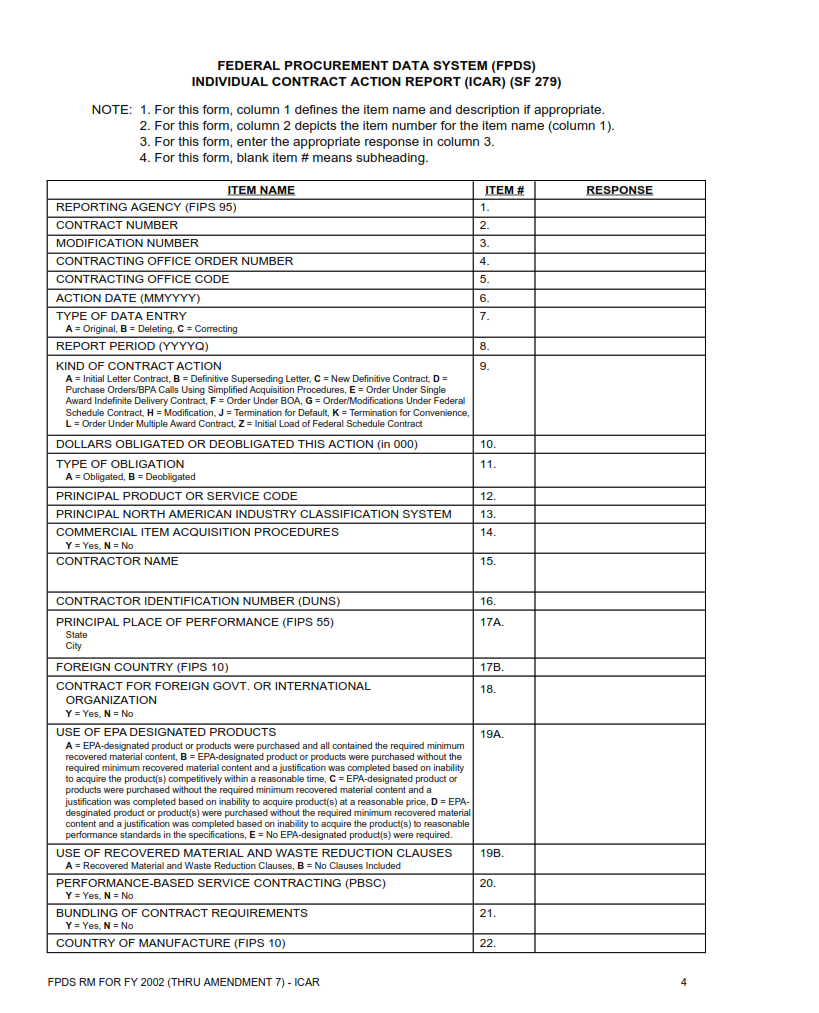SFFORMS.COM – SF 279 Form – Federal Procurement Data System (FPDS) Individual Contract Action Report – SF 279 is a form used by federal agencies to report individual contract actions. The form was created in 1990 and has since been updated several times. The latest version, SF 279A, was released in 2010. SF 279 contains data on awards, proposals, and contracts from a variety of procurement sources including competitive solicitations, task orders, sub-contracts, and purchase agreements.
Download SF 279 Form – Federal Procurement Data System (FPDS) Individual Contract Action Report
| Form Number | SF 279 Form |
| Form Title | Federal Procurement Data System (FPDS) Individual Contract Action Report |
| File Size | 566 KB |
| Date | 01/2002 |
What is an SF 279 Form?
The SF 279 Form is a vital document used in the Federal Procurement Data System (FPDS) to report individual contract actions. The purpose of this form is to gather information about government contracts, including the company or contractor awarded the contract, the amount of money awarded, and other relevant details. This data is then collected and stored by FPDS for use in federal procurement analysis.
The SF 279 Form contains numerous fields that must be completed accurately and thoroughly to ensure that all required data is captured. Some of these fields include the date of award, the type of contract action (such as new award or modification), the dollar value of the action, and a brief description of what was purchased. The form also requires information regarding any set-aside programs utilized during procurement.
Overall, completing an SF 279 Form correctly is crucial for government contractors who want to participate in future procurement opportunities. By providing accurate data on their past performance with federal contracts, they can build a positive reputation with government agencies and increase their chances of being selected for future bids.
What is the Purpose of the SF 279 Form?
The SF 279 Form is the Federal Procurement Data System (FPDS) Individual Contract Action Report. This form is used to report individual contract actions that exceed the micro-purchase threshold, which is currently set at $10,000. The purpose of the SF 279 Form is to collect data on federal procurement activities and provide transparency for government spending.
Agencies use this data to track their own procurement activities and ensure compliance with regulations. Additionally, this information is used by Congress, oversight agencies, and industry groups to monitor government spending and identify trends in contracting activity. The data collected through the SF 279 Form can also be used for research purposes and to inform policy decisions related to federal procurement.
Overall, the purpose of the SF 279 Form is essential in providing accountability and transparency in government spending. It ensures that agencies are properly reporting their contract actions while also providing valuable data for analysis and decision-making.
Where Can I Find an SF 279 Form?
Finding an SF 279 Form is a relatively easy task. You can obtain the form from the General Services Administration (GSA) website or by contacting your agency’s contracting officer. The GSA website offers a downloadable PDF version of the form, which you can print and fill out manually. Alternatively, you can use an electronic version of the form available on the GSA website.
If you prefer to use an electronic SF 279 Form, you will need to register for access to FPDS-NG (Federal Procurement Data System-Next Generation). This system is used by federal agencies to collect and report data on their contracting activities. Once registered, you can access and complete the SF 279 electronically through FPDS-NG.
It is worth noting that completing and submitting an accurate SF 279 Form is crucial for maintaining transparency in government procurement activities. The information provided in this form helps federal agencies monitor their contracts’ performance, identify potential issues or inefficiencies in contract management practices, and track spending trends across various categories of goods and services purchased by the government.
SF 279 Form Example
